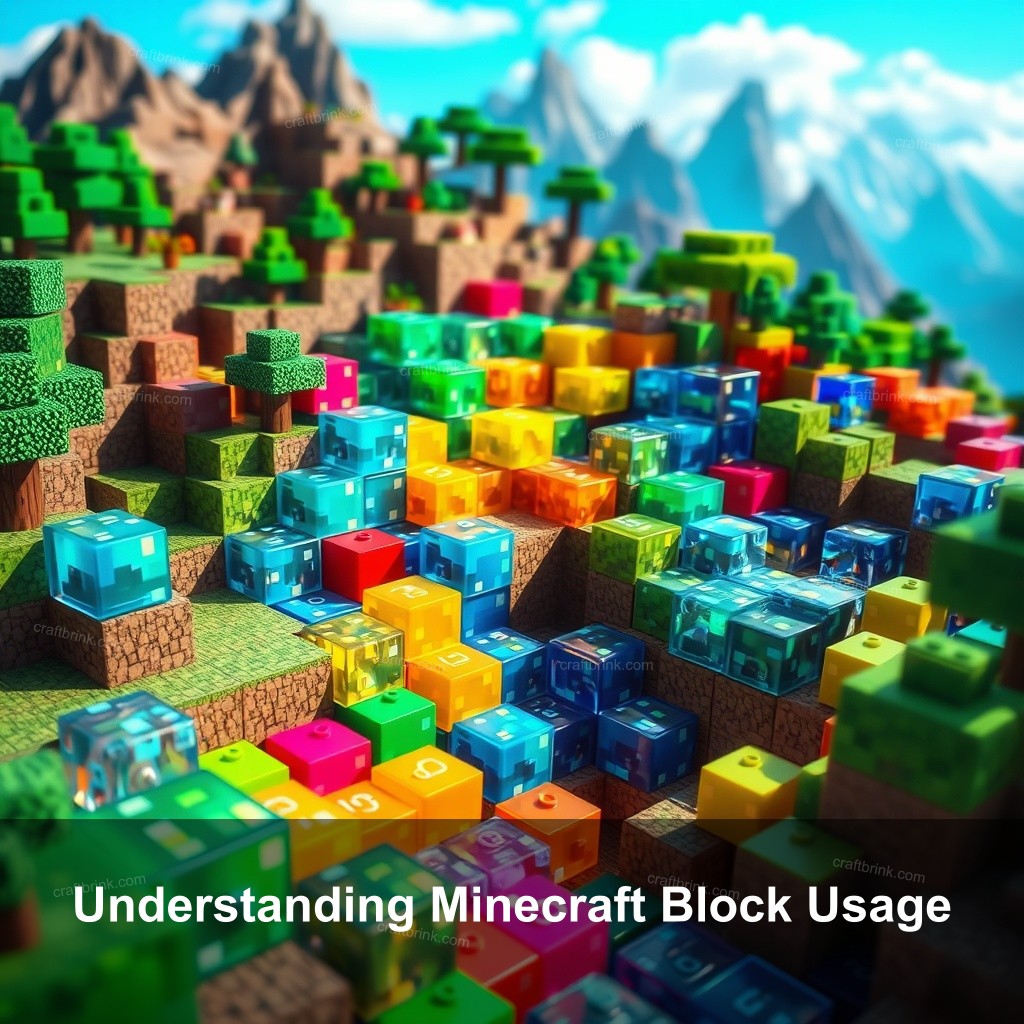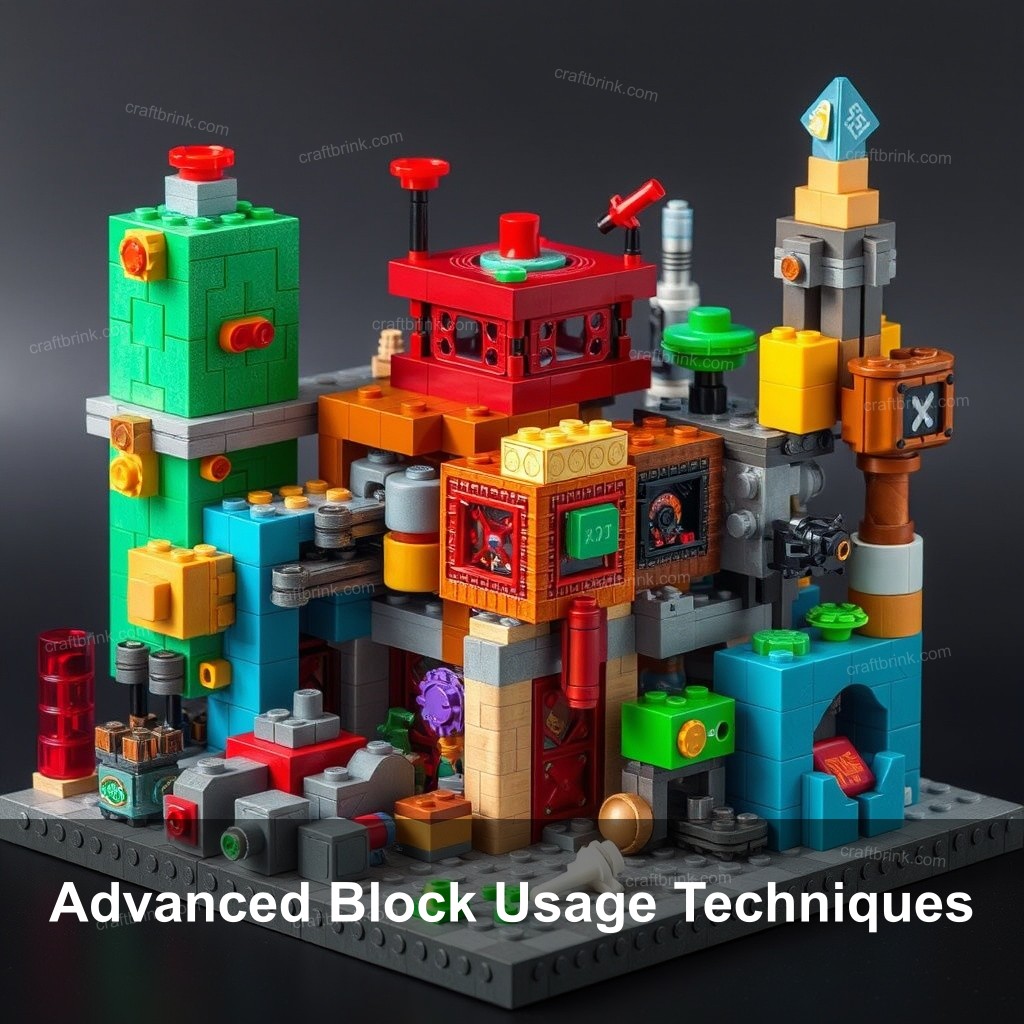Did you know that in Minecraft, the way you use blocks can completely change your gameplay experience? Whether you’re a budding architect or just starting your survival journey, comprehending how to use blocks effectively is important. In this guide by CraftBrink, we’ll explore the nuances of block usage, providing tips, tricks, and strategies for mastering the art of building and crafting in Minecraft.

Understanding Minecraft Block Usage
Minecraft is filled with a variety of blocks, each serving its own unique purpose. From the solid stone that makes up mountains to the beautiful glass used in windows, knowing the types of blocks available is fundamental to any player’s experience.
| Block Type | Description |
|---|---|
| Solid Blocks | Basic building blocks like dirt, stone, and wood. They can be stacked and used to create various structures. |
| Liquid Blocks | Water and lava that can flow and interact with solid blocks to create unique gameplay mechanics. |
| Gas Blocks | Includes air blocks, which are crucial for navigation and space in the game. |
Different block types play a role in gameplay and creativity, shaping how players approach building and exploration.
Types of Blocks in Minecraft
There are several categories of blocks in Minecraft. Let’s break down the most important ones:
- Solid Blocks: These are the basic building blocks of Minecraft, like dirt, stone, and wood. They can be stacked and used to create various structures.
- Liquid Blocks: Water and lava fall into this category. They can flow and interact with solid blocks to create unique gameplay mechanics.
- Gas Blocks: These include blocks like air, which is crucial for navigation and space in the game.
Each block type plays a role in gameplay and creativity, shaping how players approach building and exploration.
Craftable vs. Natural Blocks
In Minecraft, players can craft new blocks from resources gathered in the environment. For example, crafting tables allow players to transform wood into planks. Conversely, natural blocks such as grass or ores are found in specific biomes and can be harvested for resources. Knowing the difference between these block types can help you plan your gameplay effectively.
Block Characteristics and Properties
Not all blocks are made the same. Each block has its own properties:
- Hardness: Determines how long it takes to break a block. For instance, obsidian has a high hardness level.
- Opacity: Some blocks allow light to pass through, like glass, while others block light completely.
- Light Level: Certain blocks emit light, such as glowstone, while others can be affected by surrounding light sources.
These characteristics affect not just aesthetics but also gameplay mechanics, making it essential to choose the right block for your projects.
How to Use Blocks Effectively in Minecraft
Using blocks effectively can improve your building and gameplay experience significantly. Here are some strategies to maximize your block usage:
Strategies for Effective Block Placement
Proper block placement can transform your builds from mediocre to stunning. Here’s how to get it right:
- Plan Your Layout: Before placing blocks, sketch out your build. Planning ensures efficient use of space and resources.
- Use Slabs and Stairs: These blocks create smoother transitions and add depth to your structures.
- Consider Accessibility: Ensure your builds are easy to navigate. This includes using ladders or stairs for vertical spaces.
These strategies will help you create functional and visually appealing builds.
Functional Uses of Blocks
Blocks are not just for creating; they serve various functions in the game:
- Redstone Mechanics: Utilizing redstone blocks can automate tasks and create complex machines.
- Storage Solutions: Chests and barrels are essential for organizing items in your world.
- Crafting Stations: Tables and furnaces provide functionality for crafting and smelting.
Knowing these functionalities can help you utilize blocks more effectively.
Common Mistakes in Block Usage
Even the best builders make mistakes. Avoid these common pitfalls:
- Poor Alignment: Misaligned blocks may ruin the aesthetic of your build. Always check your placement.
- Overcomplicated Designs: Simple designs often work best. Avoid clutter.
- Neglecting Block Properties: Not considering a block’s properties can lead to ineffective builds, like using ice blocks in hot biomes.
Learning from these mistakes can improve your building skills significantly.
Best Practices for Block Placement
Now that you comprehend block usage, let’s look at best practices for placing blocks.
Planning Your Builds
Every great build starts with a solid plan. Here are steps to consider:
- Layout Design: Determine the shape and style of your build before placing any blocks.
- Resource Management: Gather all necessary materials before starting to avoid interruptions.
- Visualize Layers: Plan how each layer of your build will interact with the others to create depth.
Following these steps will streamline your building process and result in more cohesive designs.
Enhancing Gameplay with Blocks
Blocks can greatly influence how you interact with the game. Here’s how:
- Integrate Functional Blocks: Use blocks that serve multiple purposes, such as crafting tables, in central locations.
- Creative Applications: Think outside the box! Use blocks in innovative ways to create unique gameplay experiences.
- Seek Inspiration: Look at community builds for ideas on how to use blocks creatively.
Incorporating these practices can enhance your overall gameplay experience.
Common Mistakes to Avoid
Building can be tricky. Here are common errors to steer clear of:
- Ignoring Block Properties: Always consider how block properties affect your designs.
- Overcrowding: Leave space in your builds for airflow and movement.
- Failure to Test Designs: Before finalizing a build, test it in-game to ensure functionality.
Avoiding these common mistakes can greatly improve your building efficacy.

Advanced Block Usage Techniques
For those looking to take their block usage to the next level, here are advanced techniques to consider.
Redstone and Block Interactions
Redstone adds a layer of complexity to block usage. Here’s what to know:
- Basics of Redstone Mechanics: Knowing how redstone interacts with blocks is fundamental for creating complex systems.
- Automated Systems: Use redstone to automate tasks, such as farms or traps.
- Troubleshooting: Common redstone issues include power loss and delayed signals. Identifying these problems is crucial for functioning systems.
These techniques can help you create impressive automated builds.
Decorative and Functional Block Usage
Balancing decoration with functionality is key. Here’s how:
- Combining Aesthetics with Functionality: Use decorative blocks that also serve a purpose, like using bookshelves for both looks and storage.
- Experimenting with Combinations: Don’t be afraid to mix different block types to create unique designs.
- Thematic Builds: Use blocks to convey a specific theme in your builds, like using sandstone in desert-themed structures.
These strategies will help you create visually appealing and functional designs.
Conclusion and Takeaways on Block Usage
Using blocks effectively is central to mastering Minecraft. From knowing various block types to implementing best practices, the techniques discussed can boost your gameplay significantly. By knowing the unique properties of each block and how they interact with each other, you can create stunning builds and automate processes that boost your gaming experience.
Feel free to share your thoughts, ideas, or experiences related to block usage in Minecraft. Join the community at CraftBrink and explore more resources to enhance your Minecraft journey!
FAQ
What are the different types of blocks in Minecraft?
Minecraft features three main types of blocks: solid, liquid, and gas. Solid blocks make up the bulk of the environment, while liquid blocks include water and lava.
How can I improve my block placement skills?
To improve block placement, practice planning your layouts, manage your resources efficiently, and avoid overcrowding your builds to ensure functionality.
What are some common mistakes to avoid when using blocks?
Common mistakes include poor alignment, neglecting block properties, and creating overly complex designs that may hinder gameplay.
How do redstone blocks work?
Redstone blocks are used to power devices and can be combined with various components to create complex mechanisms and automated systems.
What are the best practices for block usage in survival mode?
Best practices include optimizing your space, knowing the properties of blocks, and utilizing them effectively for crafting and survival strategies.
